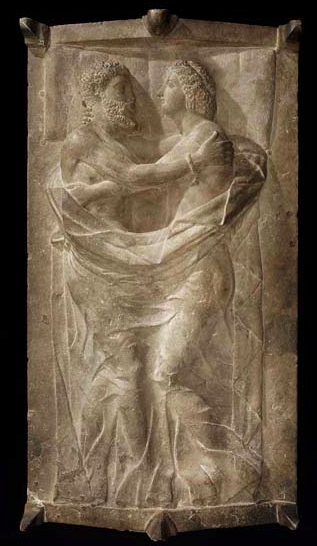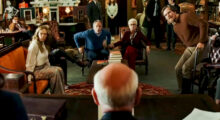 As time progressed, there was a cross-cultural pollination between the Etruscans and Greeks, where the former’s art evolved to bear the characteristics of their Hellenic neighbor’s. The highly stylized plasticity of the Etruscan figures yielded to an increasing realism, while the symposium couch in earlier sarcophagi morphed into a domestic bed, as evidenced by the Sarcophagus of the Marriage Bed currently in the Museum of Fine Arts, Boston. The lid of this 4th century sculpture is a testament to the Etruscan’s liberal attitude toward sex, the open affection permissible between married couples, as well as the comparable social status that women enjoyed.
As time progressed, there was a cross-cultural pollination between the Etruscans and Greeks, where the former’s art evolved to bear the characteristics of their Hellenic neighbor’s. The highly stylized plasticity of the Etruscan figures yielded to an increasing realism, while the symposium couch in earlier sarcophagi morphed into a domestic bed, as evidenced by the Sarcophagus of the Marriage Bed currently in the Museum of Fine Arts, Boston. The lid of this 4th century sculpture is a testament to the Etruscan’s liberal attitude toward sex, the open affection permissible between married couples, as well as the comparable social status that women enjoyed.
The couple lie together, gazing directly into each other’s eyes, while their embrace forms a unifying cross between them. Their bodies are nude and mirror one other: a thin sheet drapes over them from the waist down, strongly molded on to their legs. There is discernable agency on the woman’s behalf, since she is actively craning her neck toward her husband’s face while grasping the nape of his. Women in Etruscan society had far more freedom than their Greek counterparts, as the culture was permissive of their demonstrative sensuality. The Greek historian Theopompus described Etruscan women as “extraordinarily pleasure-loving” since they ate side-by-side with their husbands, as well as other men. Any of their Greek contemporaries would be shocked by the overt sexuality between husband and wife in this sarcophagus; while the Greeks were familiar with male nudity, it was unheard of for a married woman to be presented in this manner.
The couple’s heads are portrayed in high relief, and this strong dimensionality is present in their well-rounded torsos. Panning downwards, their bodies recede more into the bed, becoming flatter from their waists to their toes. Finally, their feet merely appear as an ephemeral suggestion, as there is just the slightest delineation to indicate them. The corporeality of the couple is most pronounced in their engaging upper halves, though it diminishes down to their faint extremities. Just like the Sarcophagus of the Married Couple from Part 1, there is a decreasing gradient in volume that denotes a material departure of spirit from substance.
Couples’ burials exist in many traditions, with one of the earliest known cases being the Neolithic entombment of an embracing man and woman outside of Verona. There is an intriguing, albeit remote, connection between the embracing Neolithic and Etruscan couples due to their regional proximity, despite the 3,000 year gap. Many people nowadays choose to be placed side-by-side for their eternal rest, though this most commonly occurs between married couples.
It’s a touching sentiment when couples choose to be buried together as a tribute to their years of devotion. In the wake of the debate on gay marriage, the Department of Veterans Affairs recently set a landmark precedent by allowing a gay couple to be buried together. This certainly galvanized a nationwide controversy, and while the military has not fully accepted gay marriage, this decision was certainly a step forward in its legitimization within the institution. The choice of burial with someone else is a deeply meaningful gesture that has been demonstrated by civilizations throughout the millenia; its presence in today’s culture is equally as symbolic, as well as a reflection of our definition of marriage.
Related articles
- Near Estern Origin of Etruscans (tonynetone.wordpress.com)
- Etruscan Sarcophagi and the Marriage Bed (Part 1 of 2) – An Ancient Civilization Views Death as a Banquet in the Afterlife (sevenponds.com)
- A Few Etruscan Tombs (raxacollective.wordpress.com)

 Etruscan Sarcophagi and the Marriage Bed (Part 2 of 2)
Etruscan Sarcophagi and the Marriage Bed (Part 2 of 2)


 Having an Estate Plan Is Essential – So Is Discussing It With Your Children
Having an Estate Plan Is Essential – So Is Discussing It With Your Children
 The Healing Sound of Singing Bowls
The Healing Sound of Singing Bowls
 “Summons” by Aurora Levins Morales
“Summons” by Aurora Levins Morales














